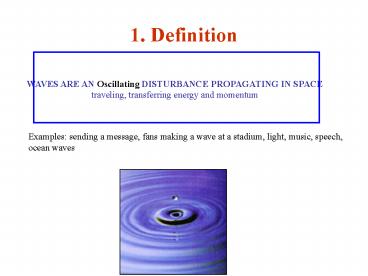1' Definition PowerPoint PPT Presentation
1 / 22
Title: 1' Definition
1
1. Definition
WAVES ARE AN Oscillating DISTURBANCE PROPAGATING
IN SPACE traveling, transferring energy and
momentum
Examples sending a message, fans making a wave
at a stadium, light, music, speech, ocean waves
2
2. Types of Waves - Source
- Mechanical or Electromagnetic
- Mechanical travels only through a medium (air,
water, earth, string, etc.) - Electromagnetic capable of transferring energy
and momentum(movement) through a vacuum
Is this mechanical or electromagnetic? What is
the medium?
3
2. Types of Waves - Motion
B. 1. Transverse oscillations perpendicular to
the direction of propagation
B. 2. Longitudinal oscillations parallel to the
direction of propagation
Rarefaction
4
2. Types of Waves - Motion Combination
Transverse and longitudinal components
5
2. Types of Waves - Duration
a. Pulses
Pulse a short disturbance propagating in space
6
2. Types of Waves
b. Periodic waves
Periodic Waves continuous periodic oscillation
driven by a periodic driving force
Wavelength
Crest
Trough
7
3. Characteristics of a Periodic Wave
Amplitude measures the amount of particle
vibration, the greatest distance the particles
move from rest points Wavelength measures the
distance between two equivalent parts Crest
highest portion portion of a wave Trough lowest
portion of a wave
Wavelength
Crest
Trough
8
Longitudinal waves
Rarefaction relaxed state. Medium is relaxed
or particles are apart. Compression Condensed
state. Medium is compressed (spring) or
particles are close together. Sound waves are
longitudinal waves
9
3. Characteristics of Periodic Waves
a. Frequency How often a vibration occurs. the
number of complete waves or oscillations passing
a point in space in a given time interval.
b. Wavelength the distance between two
equivalent parts of the wave (l)
10
Wave mathematics
- Frequency
- Unit of frequency per second Hertz (Hz)
- How many cycles (complete waves) per second
- 1 cycle (wave) per second 1 Hz, 2
cycles/second 2 Hz - Period
- The time needed to create a single vibration
1 period
1 Frequency
11
Wave Speed
- Depends on the medium
- Sound waves travel fastest in a solid, then
liquid, then air - Waves travel as fast as they can disturb the next
particle - Solid particles are closer together
- Light has a finite speed. 186,000 mi/s. It is
slowed down by water or air (but DOES NOT does
not require a medium!)
Velocity lf Where l wavelength (wave
speed) and f frequency
12
4. Mathematical Description of Periodic
(Harmonic) Waves
Wave speed equation
T
v - speed of the wave, f - frequency, l
wavelength T Period Time for 1 wave to pass,
so frequency 1/T
13
5. Wave Properties
- Reflection
Free Boundary
Fixed Boundary
14
5. Wave Properties
a. Reflection
Reflection The bouncing back of waves when
meeting a surface or boundary. Fixed boundary
Wall is too heavy to move. An opposite, but
equal reaction is generated and the reflection
travels back on the reverse side of the rope.
15
5. Wave Properties
b. Interference
Waves that converge or are momentarily on top
of each other. If you have waves of the same
frequency and crests converge you get
constructive interference (amplification) If a
crest and trough converge, you get destructive
interference (two sounds no sound!)
16
5. Wave Properties Contructive Interference
INTERFERENCE OF HARMONIC WAVES superposition of
waves of the same wavelength and frequency
17
5. Wave Properties Destructive Interference
- INTERFERENCE OF HARMONIC WAVES
- Superposition (waves come together at exactly the
same time and place. - Total destructive interference (no sound or
light) comes ONLY when waves are the same
wavelength and frequency
18
5. Wave Properties
c. Refraction
Bending of waves when two mediums
19
5. Wave Properties
d. Diffraction Why can I hear outside the door?
Waves entering a narrow doorway will spread as if
a new wave were created. DIFFRACTION bending of
waves as they pass an edge.
20
Sound Properties - Doppler Effect
- Pitch is determined by the frequency of sound
waves - Frequency changes when the source of the waves is
moving. - You hear high pitch, then low pitch
Pitch is determined by the frequency of the sound
waves Frequency changes when the source of the
waves is moving
lectureonline.cl.msu.edu/mmp/applist/doppler/d.ht
m
21
Sound Properties Sonic Boom
- Travel faster than the speed of sound
- Hear nothing in front of the plane
- Depending on position, hear the boom or just the
plane, behind the plane.
22
WAVE MOTION
- Definition
- Types of Waves
- Mechanical and Electromagnetic
- Transverse and Longitudinal
- Pulses and Periodic Waves
- Characteristics of Periodic Waves
- Wavelength
- Amplitude
- Trough and Crest
- Frequency
- Mathematical Properties
- Wave Properties
- Reflection
- Refraction
- Superposition and Interference
- Diffraction

